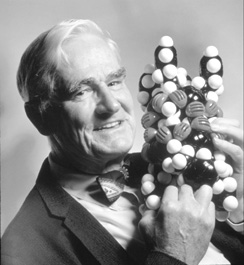Cram, Donald James (1919-2001), an American chemist, pioneered the building of artificial molecules. He succeeded in synthesizing molecules that are able to behave like the molecules of living things, in that they “recognize” and attach themselves to specific atoms. The molecules Cram produced have many practical applications. They are used to control chemical reactions. They are also used in medicines, delivering active ingredients in controlled dosages long after the medicine has been taken. Cram shared the 1987 Nobel Prize for chemistry with Jean-Marie Lehn of France and Charles J. Pedersen of the United States.

In the 1950’s, Cram attempted to produce artificial enzymes. Enzymes are protein molecules that speed up chemical reactions in all living things. Cram and his colleagues hoped to produce simpler, cheaper molecules that could do the job of enzymes. They were helped by the work of Charles Pedersen of the Du Pont company in Wilmington, Delaware. Pedersen had prepared a new class of substances called crown ethers. The molecules in these substances usually consist of carbon, hydrogen, and oxygen atoms arranged in a “crown” shape, or ring. Pedersen could vary the composition, size, and shape of the crown to trap a variety of different metal ions. These substances are called host molecules and the metals they trap are the guest substances.
Cram and his colleagues worked to develop host molecules that would be more effective at trapping guest molecules. They designed possible molecules using ball-and-stick models representing atoms and the chemical bonds between them, and then successfully made these molecules in the laboratory. Over the next 20 years, Cram produced hundreds of host molecules.
Cram went on to develop carcerands, bowl-shaped molecules that can be bonded together in pairs at their rims, trapping other molecules inside, in molecular-scale “laboratories.” Chemists can use the same principle to develop medicines: molecules of an active ingredient can be sealed inside inactive coatings that slowly dissolve, releasing the contents at a controlled rate.
Cram was born in Chester, Vermont. He earned a bachelor’s degree from Rollins College and a master’s degree from the University of Nebraska. He obtained his Ph.D. from Harvard University in 1947. After a short interval at the Massachusetts Institute of Technology (M.I.T.), he joined the staff of the University of California, Los Angeles.
